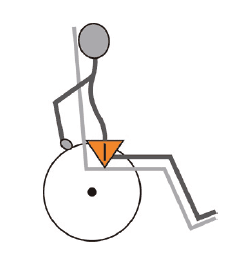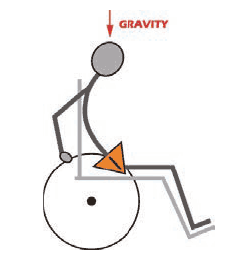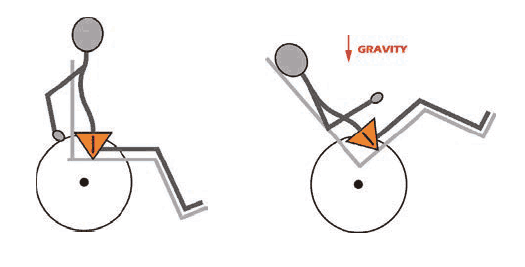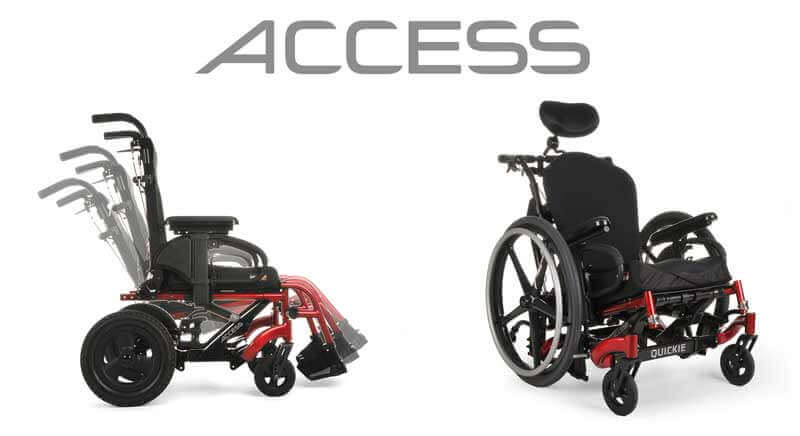Take it offline!
This Education in Motion resource is also available as a printable PDF.
Download PDF
As our clients age, it becomes important to consider decreases in strength and endurance, and also diseases that could cause disability. Strokes and other neurologic diseases become increasingly common with aging. A stroke often reduces mobility and motor control on one side of the body, creating challenges for both mobility and seated posture. This difference in strength can create postural asymmetries. Sliding out of chairs or falling also becomes common. Heart conditions, decreased lung capacity, and arthritic changes decrease mobility and strength for moving.
Additionally, in the older population the skin becomes weak and frail, resulting in an increased risk of pressure injuries. Our older clients who sit for long periods are at a high risk of developing a pressure injury. Because of these high-risk factors, wheelchairs that incorporate tilt-in-space and recline functions are routinely prescribed for this population.
When should we use tilt?
Tilt should be considered when clients:
- Are unable to independently weight shift
- Are unable to maintain pelvic, thoracic, or head position
- Balance against gravity for prolonged periods
- Are at risk of respiratory and digestive complications
- Require a change of position with reduced risk of extensor spasticity
Dynamic Tilt-in-Space
Provided changes in position for clients who cannot weight shift independently.
When individuals are unable to weight shift independently or change positions while seated upright, they are at high risk of pressure injuries. Sitting tolerance is also compromised due to the inability to redistribute pressure.
To be effective for pressure relief at the ischial tuberosities, the angle of tilt must be 25 degrees or greater. Repositioning should occur for at least one to two minutes every 30 minutes.
Provides changes in position for clients who cannot maintain pelvic, thoracic, or head position and/or balance against gravity for prolonged periods of time.
While sitting in the upright position, gravity pulls down on the body. If muscle strength or overall endurance is compromised, clients will be unable to maintain proper upright posture. This can lead to postural deviations such as a posterior pelvic tilt, thoracic kyphosis, and/or lateral lean.
Tilt helps to promote proper seating alignment and decreases potential for postural deviations. There is an increased risk for non-correctable orthopedic deviations and pressure injury on the sacrum and spine from poor posture over time.
 Upright posture must be actively maintained against gravity in a standard back support.
Upright posture must be actively maintained against gravity in a standard back support.
 Poor posture results in fatigue over time.
Poor posture results in fatigue over time.
When fatigued, tilting chairs help maintain an upright position, facilitate thoracic extension, and promote a neutral pelvis.
 Tilt reorients the body in space to reduce the effects of gravity and promote neutral posture.
Tilt reorients the body in space to reduce the effects of gravity and promote neutral posture.
Provides appropriate position and promotion of "life box" functions.
It is essential we protect and promote a client's "life box" (circulation, respiration, and digestion). If a client cannot maintain an upright posture, the respiratory system can become compromised. The diaphragm has less room to drop as it contracts, so the lungs do not fully expand.
This can result in:
- The collapse of lower parts of the lung (atelectasis)
- Immobilized secretions, potentially resulting in pneumonia
- Increased difficulty to take deep breaths (breath is therefore shallower and more rapid)
Also of significance is the optimal positioning for the digestive system to work effectively. If clients cannot maintain upright posture, the digestive system can become compromised with increased risk of gastrointestinal complications:
- Food cannot pass as easily down the gastrointestinal tract - this can result in gastritis, gastric reflux, esophagitis, and/or bowel impaction.
- Head and neck position is not optimal:
- Can cause aspiration with swallowing
- Risk of choking
But the challenge is to respect the client's need for comfort, postural support, and skin protection while promoting functional independence. Important functions include independent mobility, safe transfers, and postural stability for function and interaction.
In a qualitative study on the use of tilt-in-space wheelchairs, Shankar et al. identified promoting comfort and mobilizing for participation as important outcomes that result from prescribing this type of wheelchair. This study's findings demonstrate that a user's independence with moving a wheelchair in their environment provided improved control in comfort, choice of where they wanted to be, and what they wanted to do. Additionally, studies have found that clients who were given the opportunity to self-propel their wheelchairs in the early stages of rehabilitation were much more likely to show improvements such as ambulating at their time of discharge.
Many elderly clients have difficulty with standing to get out of the wheelchair. We also know that transfers pose a safety risk to both clients and caregivers. A safe and effective transfer can make a big difference in the health and well-being of our clients. Therefore, it is important to consider seat-to-floor height with this type of wheelchair - not only for foot propulsion, but also for safe transfers.
With an understanding of this research, QUICKIE® developed the ACCESS™.
 The QUICKIE ACCESS is the only knee-pivot chair with two tilt ranges (-5° to 20° and 0° to 25°).
The QUICKIE ACCESS is the only knee-pivot chair with two tilt ranges (-5° to 20° and 0° to 25°).
Knee-pivot wheelchairs (with pivots at the knee) have very different characteristics than center-of-gravity-pivot chairs. The forward pivot location provides low knee rise during tilt, enabling easy foot propulsion and clearance under tables for easier social engagement.
Additionally, with its low seat-to-floor height, safe and functional transfers are made much easier, even for more involved clients.
What sets the QUICKIE ACCESS apart? It has the following advantages:
- Ability to choose a tilt range that provides optimal pelvic stability and skin protection without compromising mobility
- Offers a pressure-relieving range that goes to 25° tilt and 40° recline
- Offers an anterior tilt setting to help with transfers
- Features a very low 12" seat height - very useful when you need to have a thicker pressure-relieving cushion
- More rigid than a folding chair, offering efficient mobility and propulsion
- Higher standard weight capacity (300 lbs. / 136 kg)
- Large offering of options to meet individual needs
References
- Consortium for Spinal Cord Medicine, Pressure Ulcer Prevention and Treatment Following Spinal Cord Injury: A clinical guideline for Health-Care Professionals 2nd., 2014.
- Jan, Y., Liao, F., Jones, M. A., Rice, L. A., & Tisdell, T. (2013). Effects of Durations of Wheelchair Tilt-in-Space and Recline on Skin Perfusion Over the Ischial Tuberosity in People With Spinal Cord Injury. Archives of Physical Medicine and Rehabilitation,94(4), 667-672.
- Benjamin, E. J., Blaha, M. J., Chiuve, S. E., Cushman, M., Das, S. R., Deo, R., ... Muntner, P. (2017). Heart disease and stroke statistics – 2017 update: a report from the american heart association. Circulation, 135(10).
- Chamberlain, M. A., & Munton, J. (1984). Designing chairs for the disabled arthritic. Rheumatology, 23(4), 304-308.
- Haesler, E. (Ed.), (2014). National Pressure Ulcer Advisory Panel, European Pressure Ulcer Advisory Panel and Pan Pacific Pressure Injury Alliance. Prevention and Treatment of Pressure Ulcers: Quick Reference Guide. Osborne Park, Australia: Cambridge Media.
- Hitoshi K., Yoko I., Sumiko O., Eiichi S., (2011). Body Positions and Functional Training to Reduce Aspiration in Patients with Dysphagia. Japan Med Association Journal, 54(1): 35-38.
- Lee, M. Y., & Lee, H. Y. (2013). Analysis for sit-to-stand performance according to the angle of knee flexion in individuals with hemiparesis. Journal of Physical Therapy Science, 25(12), 1583-1585.
- Lee, S.-K., & Lee, S.-Y. (2016). The effects of changing angle and height of toilet seat on movements and ground reaction forces in the feet during sit-to-stand. Journal of Exercise Rehabilitation, 12(5), 438-441.
- Shankar, S., Ben Mortenson, W., & Wallace, J. (2015). Taking control: an exploratory study of the use of tilt-in-space wheelchairs in residential care. American Journal of Occupational Therapy, 69(2).
- Singh, R., Hunter, J., Philip, A., & Todd, I. (2006). Predicting those who will walk after rehabilitation in a specialist stroke unit. Clinical Rehabilitation, 20(2), 149-152. https://doi.org/10.1191/0269215506cr887oa
- Sonenblum, S. E., & Sprigle, S. (2011). Distinct tilting behaviours with power tilt-in-space systems. Disability and Rehabilitation: Assistive Technology, 6(6), 526-535.
- Sonenblum, S. E., & Sprigle, S. H. (2011). The impact of tilting on blood flow and localized tissue
- Sutherland, S. (2020, August 5). Let's talk about the "life box". Posture & Mobility. Retrieved April 4, 2022, from https://postureandmobility.com/blogpost/lets-talk-about-the-life-box
- Weiner, D. K., Long, R., Hughes, M. A., Chandler, J., & Studenski, S. (1993). When older adults face the chair-rise challenge: a study of chair height availability and height-modified chair-rise performance in the elderly. Journal of the American Geriatrics Society, 41(1), 6-10.